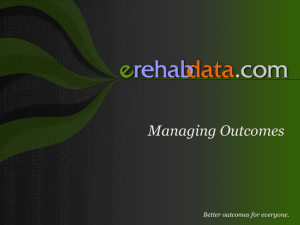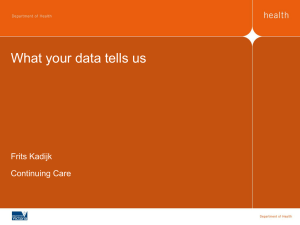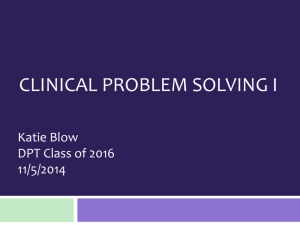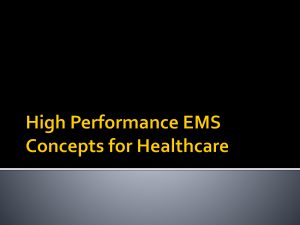Managing_Outcomes_12_07
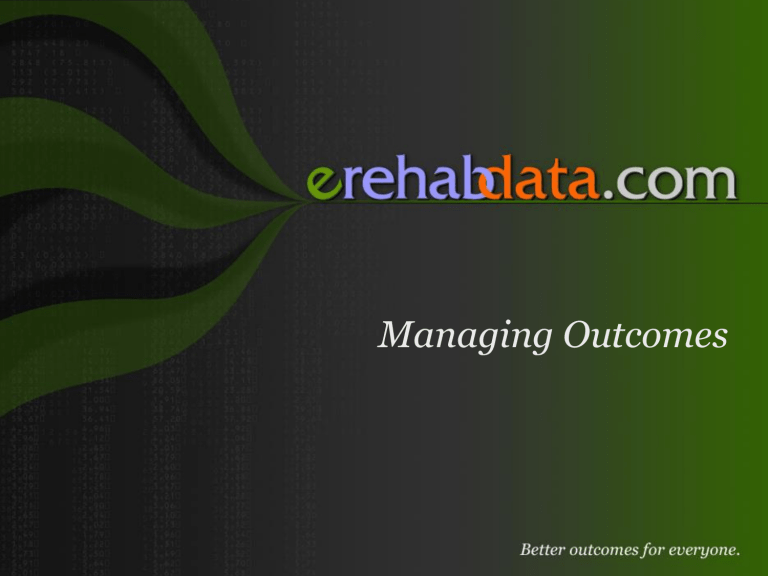
Managing Outcomes
Learning Objective
As a result of this session, the participant will:
Identify areas of clinical performance that relate to positive patient outcomes.
Have strategies for drilling down to uncover performance issues.
Data Analysis
Why do we do it?
Accurate outcome data is a powerful tool that can be used to educate key decision makers in the hospital, potential patients, payers, and the community at large.
Marketing efforts are enhanced when outcome information is used during direct marketing calls.
The team benefits from use of outcome information by being able to see where they are the most effective and also by being able to focus improvement efforts.
Breaking down your performance may reveal opportunities to capture the burden of care and yield greater reimbursement.
Facility Report
• Case Mix Index
Are you getting paid for the work that you do?
Does it seem like your CMI is lower than your burden of care?
• Capturing the proper CMI is essential to enable you to staff appropriately.
• Since many of us predict staffing ratios based on patient acuity as realized through the CMI, it is important to capture what most closely reflects the care being rendered on the unit.
Facility Report
• Case Mix Index:
Benchmark against the nation and the region.
Investigate the components-
• Rehabilitation Impairment Classification
• Motor FIM Subscale Weighted Score at Admission
• Age
• Tier Assigning Co-morbid Conditions
Investigate the distribution of impairment groups,
CMG, or RIC.
Investigate the components for the most common groups.
Facility Report
•
Average Medicare Expected Reimbursement:
Based on Medicare reimbursement
Adjusted for your facility pricer as updated through eRehabData
Includes calculations for transfer payments and short stay reductions
Facility Report
•
Transfer Patients:
Percentage of patients that are discharged to another
Medicare bed
• Acute care
• SNF
• LTACH
• Another IRF
•
Discharge Destination:
Breakdown of discharge locations for the patient’s served
Skilled nursing and subacute designation errors
Facility Report
•
Averages:
Two benchmarks: Weighted and unweighted
Onset days: Different instructions by RIC
Length of stay considerations
FIM scoring data-
• Admission Totals
• Discharge Totals
• FIM Change
• Motor subscale at admission
Facility Report
•
Individual FIM Items:
Admission, discharge, change, and follow-up
Explains difference between facility totals and benchmark totals
First glance at isolating FIM scoring errors
Drill-Down
•
Case Mix Index:
Capturing Tiering Co-Morbidities
• Considerations-
Which tier level?
Which RIC, IGC, CMG?
Which codes?
Capturing the burden of care
• Considerations-
Weighted and unweighted FIM motor subscale comparisons at admission
Which RIC, IGC, CMG?
Which items?
Assessment warnings?
Drill-Down
Assigning the proper IGC and etiologic diagnosis
• Considerations-
Which warnings?
How often?
Strategies
• Performance Improvement Strategies:
Evaluation the documentation for areas that need improvement.
• Is IGC stated?
• Are all conditions being treated diagnosed in the physician assessments, consults, or progress notes?
Ensure that the coders are on top of the rehab coding process.
Communicate with the coders.
Inservice staff on FIM scoring regularly.
Use data to direct staff education for accurate FIM scoring.
Drill-Down
• Reimbursement:
Determine which populations have the greatest transfer payment percentages.
Evaluate length of stay by RIC, IGC, CMG.
Review discharge destinations by group.
Use the patient report to identify outliers.
Strategies
• Transfer Patients and Discharge Destination:
Evaluate the patient selection process to be certain you are taking the right patients.
Be creative with scheduling therapy times in order to help the patient build endurance to meet the 3-hour rule.
Develop nursing skills for acute care delivery. Make sure that your medical director is willing to take care of conditions that may require consultations or closer monitoring.
Keep your eye on the discharge plan. Are you using Metrics reports appropriately?
Remember that before transferring a patient to a skilled or long-term care bed, the patient should be performing at their best while meeting the conditions of participation for the IRF level of care.
Drill-Down
• Averages:
Onset days should be evaluated on a RIC basis to ensure you are hitting your targets given the definition stated in the IRF-
PAI Training Manual.
• RIC Report
• Referral date to admission date
Length of Stay should be evaluated to ensure you are hitting your targets.
• RIC, IGC, CMG, Patient Report
Drill-Down
• Averages:
FIM Scores
• Total Admission FIM shows patient’s overall burden of care and potentially indicates barriers to progress or expected rate of progress.
• Total Discharge FIM shows patient’s achieved performance. Scores are gathered across the last 3-days of the stay. Facility identifies patient’s best performing
24-hour period and the lowest scores from that day are reported on the IRF-PAI.
• FIM Change is the amount of gain from admission to discharge and is also reported on a per day gain basis.
Considerations:
Totals reviewed for total population
Totals reviewed by RIC, IGC, CMG
Items reviewed in for total population
Items reviewed by RIC, IGC, CMG
FIM Scoring Comparison Graph
Time-Series Graph
Metrics
Strategies
•
Averages:
Evaluate screening and admission process to determine if patients are being admitted at the right time in their recovery.
Evaluate initial IRF-PAI scores for proper scoring
• Be sure that the lowest score is taken from the documentation
• Be sure that a full set of scores is captured daily
• Set the stage for accuracy through communication among team members
Evaluate the effect of the volume factor.
Start an ADL program, ambulation group, cognitive group, etc to focus on enrichment of skills learned in 1:1 sessions.
Measuring Goal Attainment
•
Goal setting is important!
Patient metrics page reports admit, discharge, goal, and gain.
Review again goal at team and following discharge for success with goal attainment.
Strategies
Goal Attainment:
Emphasize goal revision on the plan of care.
Inservice on goal setting to include proper goal setting and progression of treatment through incremental goal achievement.
Begin reviewing long term goals in the weekly team conference.
Determine a method to communicate current status and goals regularly through a functional status board, stand-up meetings, and/or team conference.
Other Views
•
Time Series Graphs:
Look at performance over time
Multiple indicators can be viewed simultaneously
Data tables are useful tools for report preparation
Other Views
•
FIM Scoring Comparison Graph:
Graphs admission, discharge, and change scores for the facility and region/nation
Review weighted and unweighted comparisons
Helps identify items that may require special attention in order to accurately represent the burden of care
Other Views
• 75% Rule Report:
Know how you will report your compliance to the FI: admissions or discharge
Know your cost report year and look back periods
Manage conditionally compliance closely
Other Views
•
75% Rule Report:
Confirm the final IRF-PAI with the patient’s status on the compliance report
• Presumptive or conditional?
• In order to appear on this report correctly, you will answer questions on the eRD tab to determine if the patient is 75% compliant or not.
• Review the detailed assessment to determine what makes the patient compliant.
Other Views
•
75% Rule Compliance Threshold:
Provided that each patient is properly identified on your 75% report, the compliance threshold established for your current reporting period is adequate.
Every patient that meets the criteria for inpatient rehabilitation deserves to receive that level of care.
• Therefore, operating at a higher compliance while beds are empty is essentially denying a patient an opportunity to regain independence.
The key is to be sure that you capture the 75% status of each patient correctly .
Other Views
•
Dashboard:
Great tool for daily census update
Offers a 14-day projection of census decline for current case mix
Provides 30-day analysis of several indicators: CMI,
75% rule compliance, RIC distribution, and payor source breakdown
In order to provide data, your bed configuration and pricer need to be up to date
Other Views
•
Referrals Outcomes:
Designed to trend referral sources, referring physicians, and conversion rates.
Offers information on reasons for denied admission.
You can filter the information to drill down on physician, referral source, internal vs. external fill, and reason for denied admission.
Other Views
• Referrals Outcomes:
Use information to determine referral trends by-
• Referral source
• Referring physician
• Internal versus external fill
• Zip code breakdown
• Payor source breakdown
• Conversion rates
• Reasons for denial
Drill down by RIC, CMG, and Patient
• Patient reports list patients denied
Optional Items
•
Patient Satisfaction Instrument:
3-Step Satisfaction Tools specific to rehab
• Service Recovery
• Discharge
• Follow-Up
Feedback from Stakeholders:
• Reported with demographics
• Item by item averages of responses for each item
• Same drill-down capabilities as facility reports
Optional Items
•
Patient Satisfaction Instrument:
Graphs responses to questions from each survey type for selected time period
Graphs historical trends for each question asked on the surveys
Time Series Graphs available to drill-down by patient type or demographic profile
Stores and reports narrative comments provided by patients
Optional Items
• Utilizing Feedback
Collect information through a formal patient satisfaction measure and also through patient complaints and grievances.
All data should be tracked and trended .
Ask the community advisory board or selected past patients for suggestions.
Take all suggestions to the team because they need to hear what all patients say.
Post satisfaction surveys in an area where the team can see them. Consider posting them where families can see them, too. Could be a component of a tour of the unit.
Putting It All Together
• Best Practices in Performance Improvement –
Communicate
Inservice
Peer Auditing
Use Case Studies to facilitate learning
Select a manageable number for performance indicators to work on
Report change and what worked to facilitate change
Don’t fear it!
